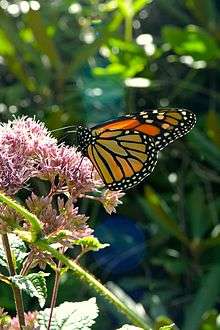Eutrochium
| Joe-Pye weeds | |
|---|---|
| | |
| Joe-Pye weed in flower | |
 | |
| Scientific classification | |
| Kingdom: | Plantae |
| (unranked): | Angiosperms |
| (unranked): | Eudicots |
| (unranked): | Asterids |
| Order: | Asterales |
| Family: | Asteraceae |
| Tribe: | Eupatorieae |
| Genus: | Eutrochium Raf. |
| Synonyms | |
| |
Eutrochium is a North American genus of herbaceous flowering plants in the sunflower family. They are commonly referred to as Joe-Pye weeds. They are native to the United States and Canada, and have non-dissected foliage and pigmented flowers.
The genus includes all the purple-flowering North American species of the genus Eupatorium as traditionally defined.[1] Eupatorium has recently undergone some revision and has been broken up into smaller genera.[2][3] Eutrochium is the senior synonym of Eupatoriadelphus.[4][5] Eupatorium in the revised sense (about 42 species of white-flowered plants from the temperate Northern hemisphere) is apparently a close relative of Eutrochium. Another difference between Eutrochium and Eupatorium is that the former has mostly whorled leaves and the latter mostly opposite ones.[6][7] Eupatorium and Eutrochium are both placed in the subtribe Eupatoriinae, but South American plants which have sometimes been placed in that subtribe, such as Stomatanthes, seem to belong elsewhere in the tribe Eupatorieae.[3]
- Species[8]
- Eutrochium dubium (Willdenow ex Poiret) E. E. Lamont – Coastal Plain Joe-Pye Weed
- Eutrochium fistulosum (Barratt) E. E. Lamont – Hollow Joe-Pye Weed
- Eutrochium maculatum (Linnaeus) E. E. Lamont – Spotted Joe-Pye Weed [9]
- Eutrochium purpureum (Linnaeus) E. E. Lamont – Sweet Joe-Pye Weed, Green-stemmed Joe-Pye Weed, Queen of the Meadow, Gravel Root, Kidney Root, Purple Boneset
- Eutrochium steelei (E. E. Lamont) E. E. Lamont
Medicinal
Joe Pye (Jopi in the Native tongue), an Indian healer from New England, used E. purpureum to treat a variety of ailments, which led to the name Joe-Pye weed for these plants.[10] Folklore says that Joe Pye used this plant to cure fevers. Folklore also states that American colonists used this plant to treat typhus outbreaks.[11] The author Hemmerly writes that the Indians used Joe Pye Weed in the treatment of kidney stones and other urinary tract ailments.[12]

References
- ↑ Siripun, Kunsiri Chaw & Schilling, Edward E. (2006): Molecular confirmation of the hybrid origin of Eupatorium godfreyanum (Asteraceae). Am. J. Bot. 93(2): 319-325. PDf fulltext
- ↑ Ito, Motomi; Watanabe, Kuniaki; Kita, Yoko; Kawahara, Takayuki; Crawford, D.J. & Yahara, Tetsukazu (2000): Phylogeny and Phytogeography of Eupatorium (Eupatorieae, Asteraceae): Insights from Sequence Data of the nrDNA ITS Regions and cpDNA RFLP. Journal of Plant Research 113(1): 79-89. doi:10.1007/PL00013913 (HTML abstract)
- 1 2 Schmidt, Gregory J. & Schilling, Edward E. (2000): Phylogeny and biogeography of Eupatorium (Asteraceae: Eupatorieae) based on nuclear ITS sequence data. Am. J. Bot. 87(5): 716-726. doi:10.2307/2656858 PMID 10811796 PDF fulltext
- ↑ Lamont, Eric E. (2004): New combinations in Eutrochium, an earlier name for Eupatoriadelphus. Sida 21: 901-902.
- ↑ Lamont, Eric E. (2006): 393. Eutrochium Rafinesque. In Flora of North America: North of Mexico, Vol. 21 (Magnoliophyta: Asteridae, part 8: Asteraceae, part 3): 461-462, 474-475. ISBN 0-19-530565-5
- ↑ 393. Eutrochium Rafinesque, Flora of North America
- ↑ 392. Eupatorium Linnaeus, Flora of North America
- ↑ The Plant List, search for Eutrochium
- ↑
- ↑ Blanchan, Neltje (2005). Wild Flowers Worth Knowing. Project Gutenberg Literary Archive Foundation.
- ↑ Audubon Society (1988). The Audubon Society Field Guide to North American Wildflowers, Eastern Region. New York: Alfred A. Knopf, Inc.
- ↑ Hemmerly, T. E. (2000). Appalachian Wildflowers. Athens, Georgia: University of Georgia Press.
| Wikimedia Commons has media related to Eutrochium. |